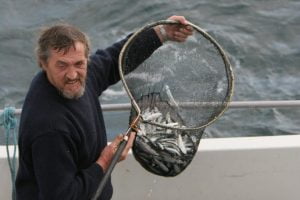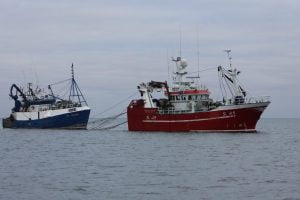The recent closure of the Celtic Sea herring fishery brings to the fore, the desperate plight of forage fish in Irish waters, and points clearly to the fact that stocks of both herring and sprat have been seriously overfished during the last few decades.

Forage fish are defined as species that exist in the upper layers of ocean waters all around this planet, are generally small, silvery in colour, survive in large shoals together, and feed exclusively on zoo plankton. Good examples are sardines, anchovies, sprats, herring and sand eels. They are a vital component of rich and productive fishing grounds globally, in providing a food supply for almost every other species of fish as well as most marine birds and mammals.
Historically, Irish waters were always rich with plankton and forage fish, in the form of herrings, sprats and sandeels, which in turn supported good stocks of demersal fish like cod, hake, whiting, pollack, haddock, megrims and many more species exploited by the fishing industry.
The stocks of Irish herring and sprats are now seriously depleted as a direct result of a small number of large, powerful Irish pelagic trawlers taking both species in huge quantities at the critical period when the fish are about to spawn. You don’t need to be a fisheries scientist to figure out what happens, when fish ready to spawn, are continuously and systematically removed, year upon year, decade by decade.
Unlike herring, the fishing of sprats up until now, has been unregulated, uncontrolled, without any quota or catch limits put in place. They were never exploited in Irish fishing history at any time, until the very end of the 1970’s when mid water trawlers first turned their attention to them and discovered they were much easier to catch than herring or mackerel. The once vast and glorious shoals of them that filled the bays and harbours of West Cork and beyond, are gone. They are close to extinction from overfishing, all done in the last 30 years. The local herrings that spawned in this area for centuries back in time, are already gone, fished to extinction in the 1990’s, by the same kind of vessels that are now targeting the spawning sprat shoals towards a similar fate.
With sprats at such low levels, the inshore trawling grounds of West Cork have now become barren, and not from overfishing. These areas are patches of clear ground, generally within 4 or 5 miles of the shoreline, suitable for trawling, and close enough to the landmass such that navigation could be carried out visually by using land marks,- lining up conspicuous objects or land features to pursue a tried and tested trawling track through often rocky grounds. With no electronic navigational aids like GPS or Decca in years gone by, there was no other way but to use landmarks to stay on track whilst trawling, and no grounds offshore to go to.
I have not seen a trawler in any of these areas in years now. The simple fact is there is nothing there to trawl for. Before any sprat fishing was carried out these patches were rich in fish stocks, and supported several trawlers fishing them all year round for decades. There are plenty of fishermen still living who will remember those days. Trawlers were then a 50ft + vessel with a 150 horse power gardener engine in it, and considered to be “the business”, providing a living for 4 or 5 fishermen and their families.

In the 1970’s and 80’s, the trawl would be towed for 2 hours before being hauled in. Any tow longer than that could result in too much fish at once in the cod end, making it more difficult to haul and empty. Today, most trawlers have 300 – 500 horse power and tow better designed and more effective nets for 5 hours before hauling, and seldom, if ever, worrying about an overload in the cod end. This is a good measure of how inshore fish stocks have fizzled out as the food supply of sprats was removed.
A parallel in farming could be to remove all the feed from a chicken farm and see how many chickens you have left after a year or two. Also, as a result of no sprats, there is of course, no whitebait about (larval and immature sprats). Whitebait is the most favoured prey of mackerel, so no whitebait means no mackerel about. The last few years it has become increasingly difficult to catch mackerel on feathers, they’re no longer present in the super abundance they once were.
Sea birds like kittiwakes, guillemots, razorbills, shearwaters eat nothing else but small forage fish, so they too are diminishing populations in a decreasing food supply. Their young often starving to death at the nest site whilst the parents search desperately for food that is no longer available.
Fin, humpback and minke whales, as well as common dolphins, all show a marked preference for sprats above any other prey available, so have had to adapt and change their feeding habits considerably as the sprats became less abundant. Years back, our peak season for fin and humpback whale sightings used to be in October and November, when the sprats formed into large shoals to set about spawning. Over the last few years very few large whales showed up at any of the sprat spawning sites and none of them stayed around. With little or no prey to pursue the whales move on.
Cork Whale Watch have been accused of trying to protect sprats just to perpetuate our business. This is not the case, as the reality is that whale watching in West Cork has taken on a whole new shape over the last few years, and has never been better since the sprats were thinned out! Now we have lots of dolphins, minke and humpback whales in April, May and June, (activity that was not there before in spring and early summer), attracted into the area by vast shoals of sand eels. As a direct result of sprats being decimated, lesser sand eels are flourishing like never before. Sprats feed on nothing but zoo-plankton throughout their lives and consume sand eel larva in their billions, when they are tiny creatures, just a few millimetres long, living in the plankton layers. With the removal of their once abundant predator, the population of sand eels has exploded into unbelievable numbers.
It is high time that the entire fishing industry, everyone involved in fishery management, control and conservation, understands the role of forage fish in our seas and stop the fishing of sprats, once and for all, while there are still some left to perpetuate the species.
In case anyone thinks I am anti – fishing in this statement, I would point out that I spent most of my working life as a fisherman, long before I took up whale watching. I started my fishing career in the port of Newhaven in Sussex. There was a decent fleet of trawlers working from the port when I was a young man. Forage fish were rapidly removed from the English Channel by French and British boats in unregulated fishing, until there was little or nothing left; similar to the situation here.

Dissatisfied by the standard of fishing there, I moved to West Cork in 1972 in search of better fishing and found exactly what I was looking for – waters that were rich in fish stocks, where I felt I could pursue a worthwhile career as a fisherman. When I returned to the UK for a short visit a few years later, I went back to Newhaven to catch up with old friends and see how things were going. I was shocked to see the trawler fleet in decay with vessels up for sale and hardly any boat still trawling. When I enquired asked about this situation, the answer was “there was nothing left to catch, the ground had gone barren”, just the same as the inshore trawling grounds here. Some of the boats had turned to scallop fishing to survive, about the only thing left to fish for, the remainder had packed in the fishing and sold their boats.
If there were no nephrops prawns (Dublin Bay) to trawl for off the West Cork coast, I doubt that any boat could make a living from the demersal fish stocks that remain inshore now. The message is simple, if you want good sustainable fishing to continue, and healthy well-stocked seas, then leave the sprats alone to spawn in peace and maintain their numbers, as was always the case through centuries of Irish fishing history.
By Colin Barnes





Leave a Reply